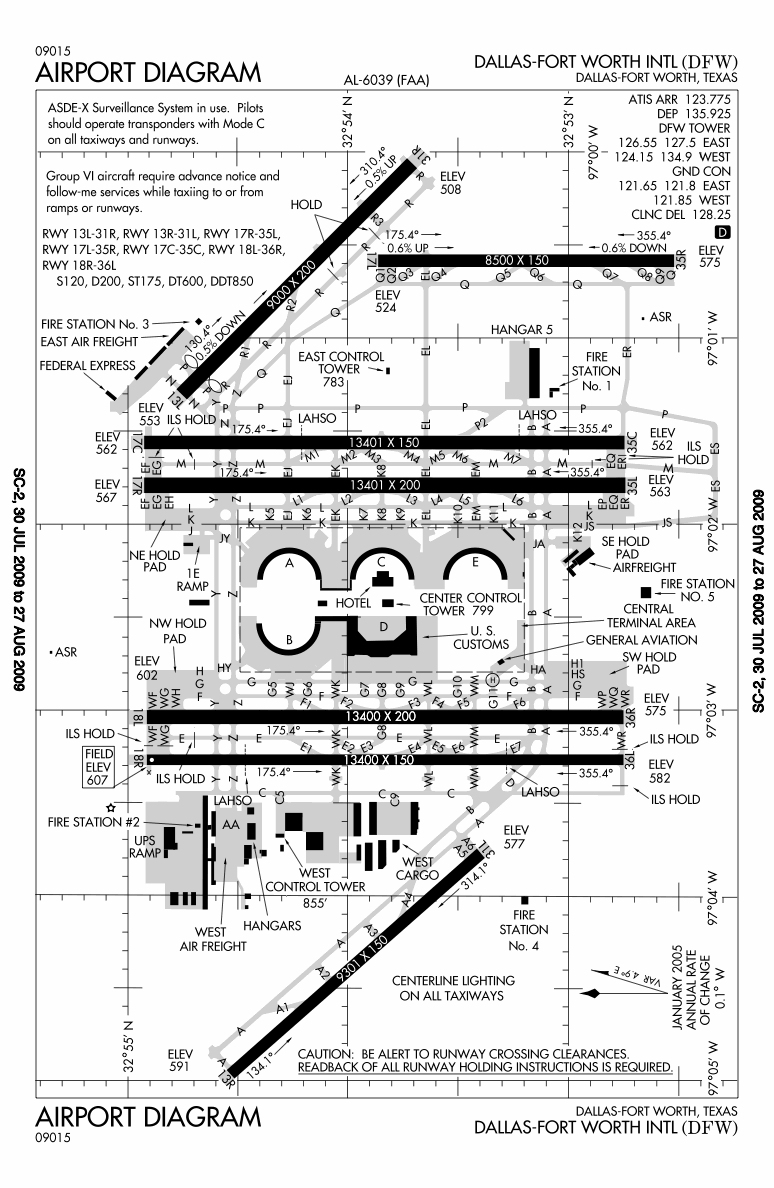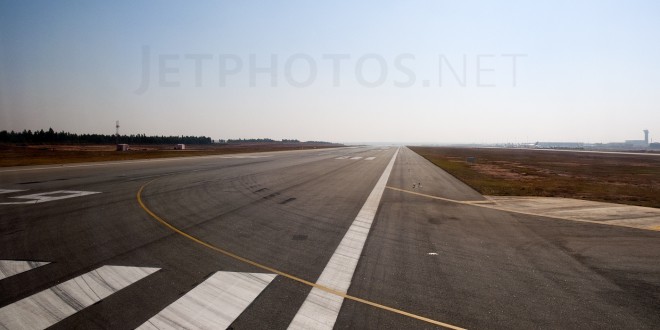What is the meaning of it and who issues it?
Simply put, a runway is a strip of land where aircraft take-off and land. It forms an integral part of an airport’s aircraft movement area.
Runway numbers
Runways are numbered between 01 and 36. The number indicates the runway’s heading. On a compass North is 360°, East is 90° South is 180° and West is 270°. You cannot have a runway zero. The two digit number is essentially 1/10th of the magnetic heading of the runway ±5° i.e. one digit per ten degrees. A runway pointing to the north with a heading from 355° to 004° will be generally given the number 36 (1/10th of 360° ±5°), similarly runway 09 points east (85°~94°), runway 18 is south (175°~184°), and runway 27 points west (265°~274°).
Since a runway can be normally used in two directions (there are always exceptions), it will have a second number which will always differ by 18 (180° or half way across the compass). In India most airports have an east-west runway 09-27.
Correct pronunciation
For better clarity in radio communications, each digit of a runway number is pronounced individually i.e. runway three six, runway two seven, etc. In case of runways with a single digit number, a leading zero is added, for example runway zero niner. (In aviation radio communications the number nine is pronounced niner for better clarity and to avoid confusion with the number five when spoken).
Left, Right, Centre?
 When an airport has two or three parallel runways pointing in the same direction, each runway is identified by appending Left (L), Right (R) and if there is a third runway, Centre (C), to the number — for example Dallas-Fort Worth International airport, has Runways One Seven Left (17L), One Seven Centre (17C), and One Seven Right (17R). Similarly, when Singapore’s Changi airport added a third runway out in the sea, the new runway became 02R, and the existing 02R became 02C.
When an airport has two or three parallel runways pointing in the same direction, each runway is identified by appending Left (L), Right (R) and if there is a third runway, Centre (C), to the number — for example Dallas-Fort Worth International airport, has Runways One Seven Left (17L), One Seven Centre (17C), and One Seven Right (17R). Similarly, when Singapore’s Changi airport added a third runway out in the sea, the new runway became 02R, and the existing 02R became 02C.
In the reverse direction the Left and Right get reversed. Runway One Seven Left (17L) becomes Runway Three Five Right (35R).
More than three parallel runways?
Certain ultra-large airports most notably Atlanta Hartsfield-Jackson (ATL), Los Angeles International (LAX) and Dallas-Fort Worth (DFW) have more than three parallel runways. In such cases the traditional left, centre, right designations cannot be used and the the runway identifiers are shifted by 10 degrees or 1 digit on the runway number). At Dallas-Fort Worth, there are five parallel runways, named 17L, 17C, 17R (on the east side of the airport), and 18L, and 18R (on the west side of the airport), even though all five runways are oriented at a heading of 175.4°.
How is runway orientation decided?
For normal fixed-wing aircraft it is advantageous to perform take-offs and landings into the wind. This is to increase the speed of air over the wings i.e. flying speed, at a relatively lower ground speed which reduces the actual take-off or landing distance needed. Thus, runway orientations are decided on the historical winds and directions. If the winds are more variable in direction and the airport is large enough to financially justify the investment, airports can have several runways in different directions, so that a runway can be selected that is most nearly aligned with the wind. A typical example will be Chicago’s O’Hare (ORD) airport which has seven runways aligned in 04-22 (L,R), 09-27 (L,R), 10-28, and 14-32 (L,R).
Runway lengths and widths
Runway dimensions vary greatly. However a typical runway is about 10,000 ft long. Bigger jets and fighter aircraft require longer runways. The width of the runway is dictated by the largest aircraft the airport would like to handle. Passenger jetliners are classified based on the width of their wings, and undercarriage width, as Code C (single aisle Airbus A320, Boeing 737 family), Code D (twin aisle Airbus A330, 340, Boeing 767, 777), Code E (Boeing 747) to Code F (Airbus A380 and Antonov An-124, An-225). Code F aircraft require runways to be at least 60m wide with another 7.5m of shoulders on each side i.e. 75m wide. There should also be no obstruction for a minimum 77.5m on either side of the runway.
The largest runway in the world is the huge 11,917 m (39,098 ft) long, 274 m (899 ft) wide lake bed runway 17-35 at Edwards Air Force Base in California – a landing site for the Space Shuttle amongst other aircraft.
Please do take the time to return tomorrow for Part 2 , where we cover more aspects of runways, including displaced thresholds, TORAs, LDAs, PCNs, ACNs, etc.
Airport Maps courtesy Wikipedia. Airport maps may not be used for actual navigation or flight operations purposes. Bengaluru International Airport runway 09 photo courtesy Devesh Agarwal. All rights reserved by the individual copyright owners.
 Bangalore Aviation News, Reviews, Analysis and opinions of Indian Aviation
Bangalore Aviation News, Reviews, Analysis and opinions of Indian Aviation





booooooo